Parts of a Plant Class 3 Notes Science
| Table of contents |

|
| Importance of Plants |

|
| Different Parts of Plants & Their Role |

|
| Parts of a Plant |

|
| Summary |

|
Have you ever wondered how plants help us every day? From the food we eat to the air we breathe, plants are all around us, supporting life in many ways. Think about the trees, flowers, and even the grass under your feet—how do you think they help the environment? Let’s take a closer look at how plants play an essential role in our lives. We’ll explore how they give us oxygen, provide food, and even help us stay healthy. Ready to discover the amazing ways plants make the world a better place? Let's dive in!
Importance of Plants
Plants are one of the most important living organisms on earth. They are very helpful to both animals and human beings
 Plants are very important to us
Plants are very important to us
- Plants are important for our survival because they produce oxygen, which is necessary for all living organisms.
- Leaves and roots of plants are used to make medicines that can be used for various treatments.
- Different parts of a plant have specific functions: roots absorb water and nutrients from the soil, stems provide support and transport water and nutrients, and leaves are responsible for photosynthesis, where plants convert sunlight into energy.
- Plants are a major source of food and oxygen and play an important role in maintaining the ecological balance of the environment.
Different Parts of Plants & Their Role
The part of the plant which grows below the soil is called the root and the part which grows above the soil is called the shoot. The shoot has stems, branches, leaves, fruits, and flowers.
- Each part of the plant plays an important role in helping the plant to live and grow.
- Let us discuss the various parts of a plant and the functions they perform.

- Root: The root is the part of the plant that grows underground. Its main function is to absorb water and nutrients from the soil.
- Shoot: The shoot is the part of the plant that grows above the ground.
- Stem: The stem supports the plant and acts as a mode for transporting water, nutrients, and food between the roots and other parts of the plant.
- Branches: Branches extend from the stem and provide a structure for the plant, allowing it to spread out and capture more sunlight.
- Leaves: Leaves capture sunlight and, along with water and carbon dioxide, produce food for the plant.
- Fruits: Fruits develop from flowers and contain seeds.
- Flowers: Flowers are the attractive parts of the plants.
- Each part of the plant has a specific and important role that contributes to the overall health and growth of the plant.
Parts of a Plant
Let us now discuss all parts in detail.1. Roots of a Plant
- Roots are an important part of all plants, and they grow underground.
- They are responsible for absorbing water and nutrients from the soil, which are important for the plant's growth and health.
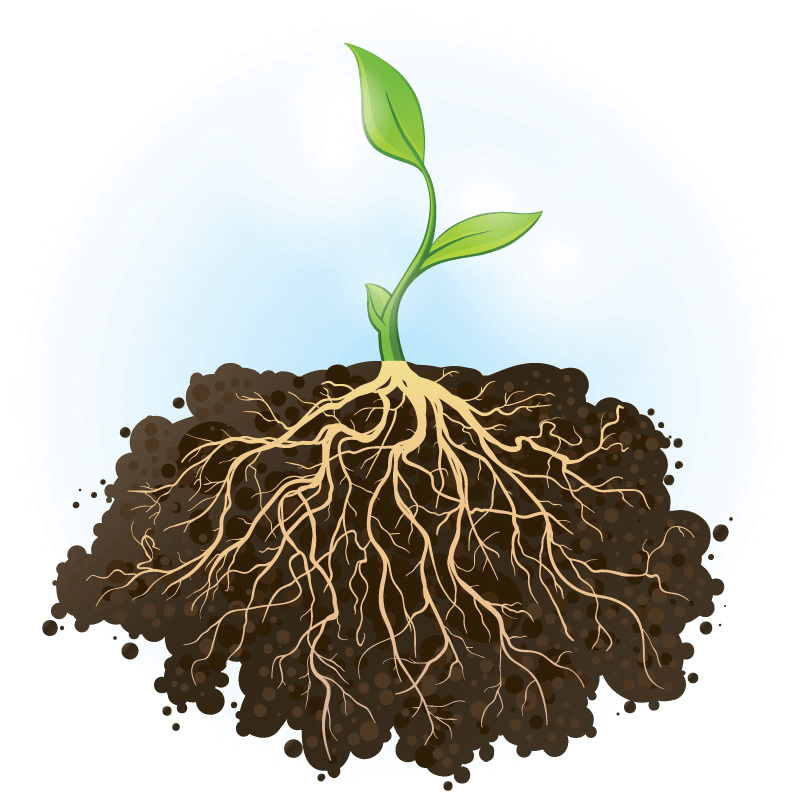 Roots of a Plant
Roots of a Plant
Different Types of Roots
Plants have different types of roots. The two main types are taproots and fibrous roots.
Taproot
- A taproot has a thick main root that is connected to the stem, with several thinner roots or branches coming out of it.
- These branches have tiny, thin, white hair-like structures called root hairs.
- Examples of plants with taproots include carrots, pulses, beetroot, and mustard.
Fibrous Root
- Fibrous roots are made up of many thin threads that are all about the same size. These roots grow from the bottom of the stem.
- Unlike taproots, there is no single main root in fibrous root systems.
- Examples of plants that have fibrous roots include grass, wheat, rice, and onion.

Functions of the Root
- Roots fix a plant securely in the soil.
- They absorb water and minerals from the soil and deliver them to the plant.
- In certain plants, such as carrots, radishes, and turnips, the roots store food produced by the plant, and these roots are eaten by us.
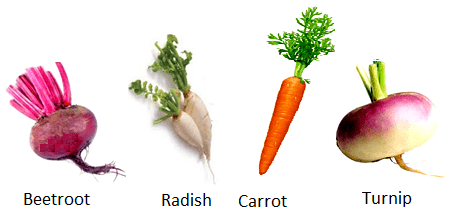 Roots as Vegetables
Roots as Vegetables
2. Stem
The stem is the primary structure of the plant. Its main functions include supporting the plant above the ground and making the transport of nutrients and water easier throughout the plant. Various parts, such as branches, leaves, buds, fruits, and flowers, develop from the stem.
Characteristics of Stems
- The stem of a large tree is referred to as the trunk, which is often protected by a thick layer of bark. On the other hand, the stem of a bamboo plant is smooth in texture.
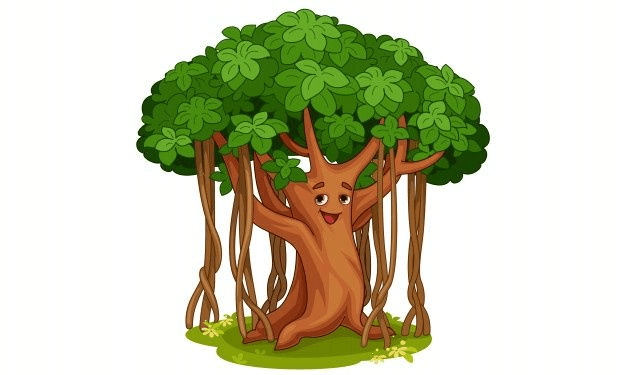 The stem of a big tree is called a Trunk.
The stem of a big tree is called a Trunk.
- The stem of a mango tree is normally rough, while the stem of a rose plant has thorns. Some plants have stems covered with fine hairs.
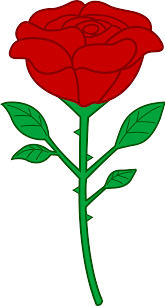 The stem of a rose plant has thorns on it.
The stem of a rose plant has thorns on it.
- Stems can be different in their branching patterns. For example, banyan trees are known for their branching stems, whereas coconut trees have a single, unbranched stem.
Different Types of Stems
- Trees like mango and banyan have thick and hard trunks.
- Shrubs like roses have several stems that grow close to the ground. They have thin and woody stems.
- Herbs like mint and coriander have green and soft stems.
- Climbers like money plants and grapevines have weak stems and need support to grow tall.
- Creepers like pumpkin and watermelon have very weak and soft stems, spreading along the ground as they grow.

Functions of the Stem
- The stem provides support to the plant above the ground.
- The stem holds the leaves so they can receive sunlight for making food. It also supports buds, flowers, and fruits.
- Water and minerals absorbed by the roots travel to the leaves through the stem.
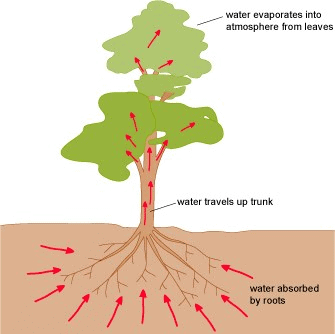 Movement of water and minerals in plants
Movement of water and minerals in plants
- The food produced by the leaves moves through the stem to all parts of the plant.
- Potatoes and onions are the stems that grow underground and store food.
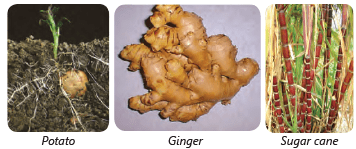
3. Leaves
Just like the stems, leaves are also important parts of plants. They are generally green and of different shapes and sizes.
Let us take a look at some leaves.
- Banana plants have big, smooth leaves, and tulsi plants have small leaves.
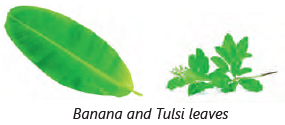
- Peepal trees have heart-shaped leaves; lotus plants have round ones.
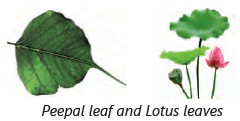
- Some leaves have a special smell. Example: mint, coriander, tulsi.
- Some leaves have toothed edges. Example: rose and hibiscus.

- The flat part of a leaf is called the leaf blade. The main veins and the side veins can be seen on the leaf blade. Water and minerals are carried through these veins.
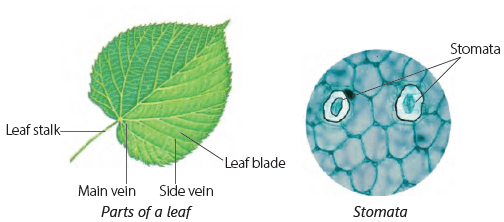
- The leaf blade has tiny holes on the bottom side called stomata. The leaf takes in air through the stomata. It also gives out excess water through the stomata. Here are some important functions of the leaf.
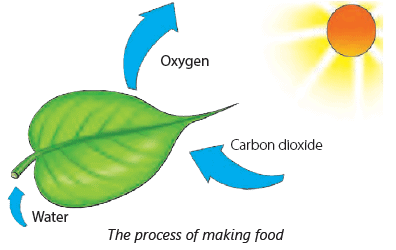
- Green leaves make food for the plant, so they are also called the kitchen or the food factory of the plant. Non-green plants like mushrooms cannot make their own food.
- Leaves give out oxygen during the process of making food. It cleans the air.
- Leaves of some plants store food. Cabbage, spinach, and mint are some leafy vegetables we eat.
4. Flower
- Buds appear on some plants as they grow, and these buds eventually develop into flowers, which are the most attractive part of a plant.
- Flowers come in a wide range of colors, shapes, and sizes. Many flowers, like roses, are known for their sweet smell.
- Some flowers develop into fruits.

- Certain flowers, such as broccoli and cauliflower, are edible.

5. Fruit
The fruit is formed from the flower and contains seeds. The primary function of fruits is to protect the seeds.
- Fruits can vary in the number of seeds they contain.
- For instance, a mango and a plum each have one seed.
- Fruits like oranges, apples, and pears have a few seeds, while papayas can have many seeds.
- Interestingly, the strawberry has its seeds on the outside of the fruit.

6. Seed
- Edible seeds are seeds that we can eat, like rice and kidney beans.
- Non-edible seeds are seeds that we do not eat, such as the seeds of an apple or a lemon.
- A plant has different parts, and each part is important for the plant's survival and growth. Some seeds can grow into a new plant, which is called germination.
Germination
Germination is when a seed starts to grow and becomes a new plant under the proper amount of water, air, and sunlight.
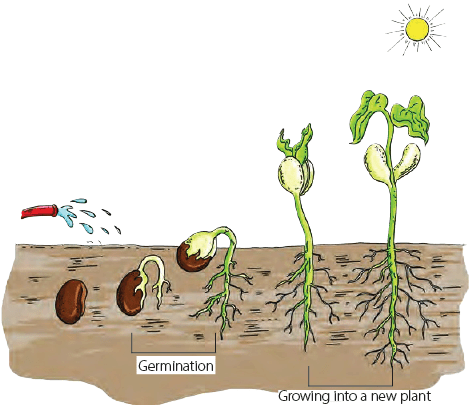 Stages of growth of a seed to a baby plant
Stages of growth of a seed to a baby plant
Summary
- A plant has two main parts: the root and the shoot.
- The root anchors the plant in the soil and absorbs water and minerals from the ground. There are two types of roots: taproots and fibrous roots.
- The shoot consists of the stem, branches, leaves, flowers, and fruits.
- The stem supports the plant above ground and transports water to the leaves. It also carries food to different parts of the plant.
- Green leaves are responsible for making food for the plant using water, sunlight, and carbon dioxide through a process called photosynthesis.
- Most flowers produce fruits, and inside these fruits are seeds. Seeds grow into new plants.
- It is important to take care of plants because they are very useful to us.
|
20 videos|121 docs|32 tests
|
FAQs on Parts of a Plant Class 3 Notes Science
| 1. Why are plants important for the environment? |  |
| 2. What are the main parts of a plant? |  |
| 3. What role do roots play in a plant's life? |  |
| 4. How do leaves contribute to a plant's growth? |  |
| 5. What is the function of flowers in a plant? |  |





















